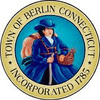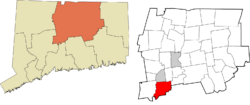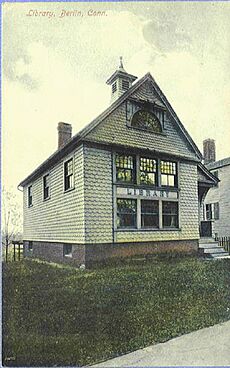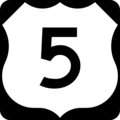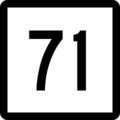Berlin, Connecticut facts for kids
Quick facts for kids
Berlin, Connecticut
|
||
|---|---|---|
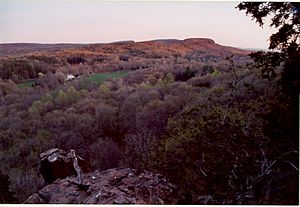
Rural Berlin from Short Mountain
|
||
|
||
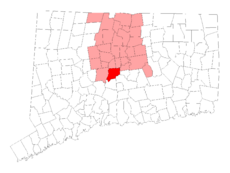 Hartford County and Connecticut Hartford County and Connecticut |
||
| Country | ||
| U.S. state | ||
| County | Hartford | |
| Region | Capitol Region | |
| Incorporated | 1785 | |
| Hamlets | Berlin East Berlin Kensington |
|
| Government | ||
| • Type | Council-manager | |
| Area | ||
| • Total | 27.0 sq mi (69.9 km2) | |
| • Land | 26.3 sq mi (68.2 km2) | |
| • Water | 0.7 sq mi (1.7 km2) | |
| Elevation | 154 ft (47 m) | |
| Population
(2020)
|
||
| • Total | 20,175 | |
| • Density | 766.2/sq mi (295.8/km2) | |
| Time zone | UTC-5 (Eastern) | |
| • Summer (DST) | UTC-4 (Eastern) | |
| ZIP Codes |
06023, 06037
|
|
| Area code(s) | 860/959 | |
| FIPS code | 09-04300 | |
| GNIS feature ID | 0213388 | |
| Major highways | ||
| Commuter Rail | ||
Berlin (pronounced BUR-lin) is a town in Connecticut, United States. It's part of the Capitol Planning Region. In 2020, about 20,175 people lived there.
Berlin became an official town in 1785. It's special because the exact center of Connecticut is located within its borders! Berlin has both homes and factories. It also has an Amtrak train station. The town includes two smaller areas called Kensington and East Berlin.
Contents
Berlin's Town Seal: The Yankee Peddler
The town's official seal tells a story about Berlin's past. It shows a "Yankee peddler" from the 1700s. This peddler wears old-fashioned clothes and carries a basket and a pack. These were full of shiny tinware items.
This image represents how Berlin's industry grew. Two brothers, Edward and William Pattison, started a tinware business around 1740. They sold their goods from baskets. As their business grew, they hired people to travel far and wide. These "Yankee peddlers" sold tinware all over America and Canada.
Soon, many people in Berlin learned the tinware trade. The sound of whitesmiths (people who worked with tin) hammering could be heard everywhere.
Berlin's Rich History
Berlin was formed from parts of several nearby towns. These included Wethersfield, Middletown, Wallingford, and Farmington. The town was once known as Kensington.
Early Settlers and Growth
In 1659, Sergeant Richard Beckley was the first settler in the area. He bought land and built a home for his family. More families arrived, and in 1686, Captain Richard Seymour led a group from Farmington. They started the first settlement on Christian Lane.
By 1705, the community was recognized as the Great Swamp Society. They built their first meetinghouse and cemetery. The first schoolhouse opened in 1717.
Becoming the Town of Berlin
In 1722, the Society was reorganized. More land was added from Farmington, Wethersfield, and Middletown. The name changed to Kensington. Later, in 1772, Kensington was split into two parts: Worthington (east) and Kensington (west).
Finally, in 1785, the town officially became Berlin. New Britain was part of Berlin until 1850.
Berlin's Role in the Industrial Revolution
Berlin played a big part in America's Industrial Revolution. Around 1700 to 1750, farms, mills, and blacksmith shops appeared. Blacksmiths made important items like tools, nails, and parts for wagons. Small ironworks used local waterpower.
During the Revolutionary War, ammunition was made from local lead mines. The East Berlin Milling Co. produced cotton and wool yarn for clothes.
Simeon North was a key figure. He became the first official pistol maker for the U.S. Government. He developed a system of interchangeable parts for pistols. This meant parts could be easily replaced, making manufacturing much faster.
In the 1800s, many businesses thrived in Berlin. They made wagons, hats, clocks, and even sleighs. Berlin was a busy stop on the route from New Haven to Hartford. Taverns and inns offered places for travelers to rest.
Community Life and Education
Berlin was proud to have one of the 75 official post offices chosen by Benjamin Franklin. A historical marker still shows that the next post office was 11 miles away in Hartford.
By the late 1700s, Berlin had a village library and five school districts. In the mid-1800s, the Worthington Academy opened. It taught 125 students from nearby states.
The Berlin Railroad Depot opened as a stop on the New York, New Haven and Hartford line. Today, this train station is one of the few places in the U.S. where you can buy tickets to almost anywhere in the U.S. or Canada.
Changes in Industry
By the mid-1800s, mass-produced goods made it hard for peddlers to compete. However, the brick-making industry started in Berlin. It produced 90,000 bricks daily until the 1960s.
Berlin's Geography
Berlin covers about 69.9 square kilometers (27 square miles). Most of this is land, with a small amount of water. As mentioned, the geographic center of Connecticut is located here.
The western side of Berlin features the Metacomet Ridge. This is a chain of mountains made of trap rock. It stretches from Long Island Sound almost to the Vermont border. Some notable mountains in Berlin are the Hanging Hills, Lamentation Mountain, Short Mountain, and Ragged Mountain.
Two long hiking trails, the Metacomet Trail (about 51 miles) and the Mattabesett Trail (about 50 miles), run along this ridge. Silver Lake is also in Berlin, with the Urrunaga Bridge crossing it.
Population and People
Berlin had a population of 20,175 people in 2020. In 2010, about 94.9% of the people were white. About 2.7% were Asian, and 0.7% were Black or African American. Around 3.2% of the population was Hispanic or Latino.
In 2000, there were 6,792 households in Berlin. About 34.3% of these households had children under 18. The average household had 2.67 people. The median age in Berlin was 41 years old.
The median income for a household in Berlin was about $68,068 in 2000. This means half of the households earned more than this, and half earned less.
Berlin's Economy
Berlin has several important employers. These companies provide many jobs for the town's residents.
Top Employers in Berlin
Here are some of the largest employers in Berlin, based on a 2022 report:
| # | Employer | # of Employees |
|---|---|---|
| 1 | Eversource Energy | 1,245 |
| 2 | Town of Berlin | 700 |
| 3 | Assa Abloy | 465 |
| 4 | Keep Me Home | 300 |
| 5 | Comcast | 245 |
| 6 | Budney Overhaul and Repair | 190 |
| 7 | TOMZ Corp | 174 |
| 8 | Parker-Fluid Control | 158 |
| 9 | Budney Industries | 146 |
| 10 | EuroAmerican Home Care | 110 |
Getting Around Berlin: Transportation

Berlin has major roads that help people travel. U.S. 5 runs north-south through the town. Connecticut State Route 9 is an expressway. Connecticut State Route 372 is a local road that goes east-west.
The town is also on the New Haven–Springfield Line for trains. You can take a train north or south from Berlin. You can also connect to New York City from New Haven. The Berlin train station in Kensington is served by CT Rail's Hartford Line and Amtrak trains.
Famous People from Berlin
Many interesting people have connections to Berlin:
- Joe Clifford (born 1970) – An author and editor.
- Luann de Lesseps (born 1965) – A cast member on the TV show The Real Housewives of New York City.
- Sam McKinniss (born 1985) – A painter known for his modern art. He grew up in Berlin.
- Simeon North (1765–1852) – A manufacturing pioneer who helped develop interchangeable parts.
- Joseph Pierce (1842-1916) – A soldier born in China who fought in the Civil War.
- Ryan Preece (born 1990) – A NASCAR race car driver.
- Austin Stowell (born 1984) – An actor in movies like Dolphin Tale and Whiplash.
- Emma Hart Willard (1787–1870) – A pioneer who worked to improve women's education.
- Gary Waslewski (born 1941) – A baseball player who started Game 6 of the 1967 World Series for the Boston Red Sox.
Schools and Learning in Berlin
Berlin has several schools for students of different ages.
- Elementary Schools: Mary E. Griswold School, Emma Hart Willard School, and Richard D. Hubbard School.
- Middle School: Catherine M. McGee Middle School.
- High School: Berlin High School.
There is also one private school, Saint Paul School, which was founded in 1958.
The town's public library is the Berlin-Peck Memorial Library. It's located in the Arthur B. Powers complex. The library has meeting rooms, a gym, and a game room. Adult education classes and group meetings are also held there.
How to Say "Berlin"
Even though the name "Berlin" comes from the capital of Prussia (Germany), which stresses the second part of its name, the town in Connecticut is pronounced with the stress on the first part: BUR-lin.
There's a story that people changed the pronunciation during First World War to make it sound different from the German city. However, the town has always been pronounced BUR-lin, following how English words are usually stressed.
Images for kids
See also
 In Spanish: Berlin (Connecticut) para niños
In Spanish: Berlin (Connecticut) para niños


